Diploma in HRM Report: HR Professional Skills and Development
VerifiedAdded on 2023/01/13
|11
|3226
|41
Report
AI Summary
This report, created for a Diploma in HRM course, provides a comprehensive overview of key aspects of human resource management. It begins by evaluating the roles and responsibilities of an HR professional, emphasizing skills like anticipating skill requirements, developing good practices, and managing performance. The report then delves into group dynamics, describing elements like communication, roles, and influence, and explores conflict resolution methods, including negotiation and arbitration. It further applies project management techniques, such as Just in Time inventory management and Kaizen, and problem-solving techniques like brainstorming and group meetings, with a focus on a retail management context. The report also explains influencing, persuading, and negotiating strategies. Finally, it includes a self-assessment of the author's skills in the area of employee relations and proposes a professional development plan, highlighting areas for improvement such as knowledge of legislations and conflict resolution strategies.
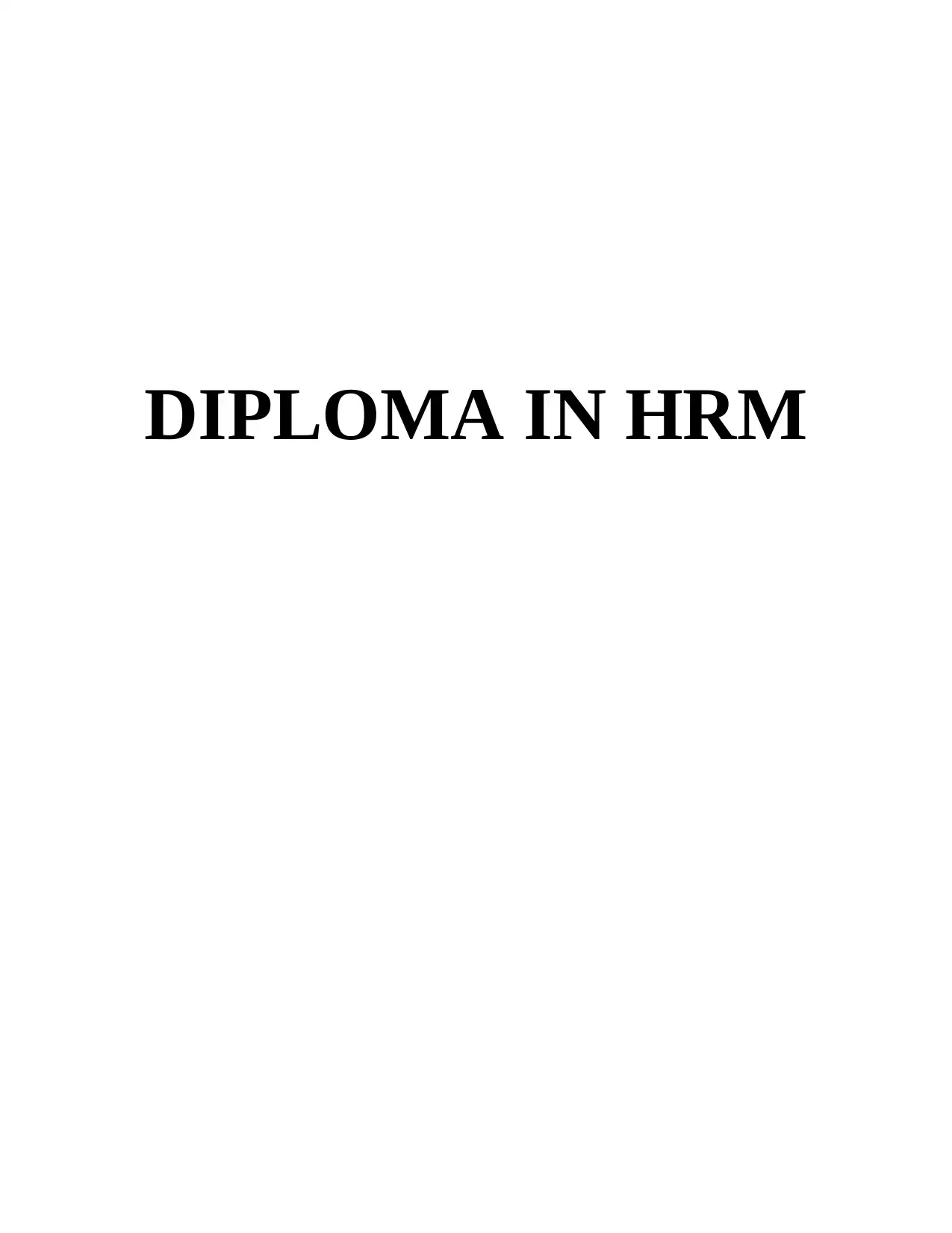
DIPLOMA IN HRM
Secure Best Marks with AI Grader
Need help grading? Try our AI Grader for instant feedback on your assignments.
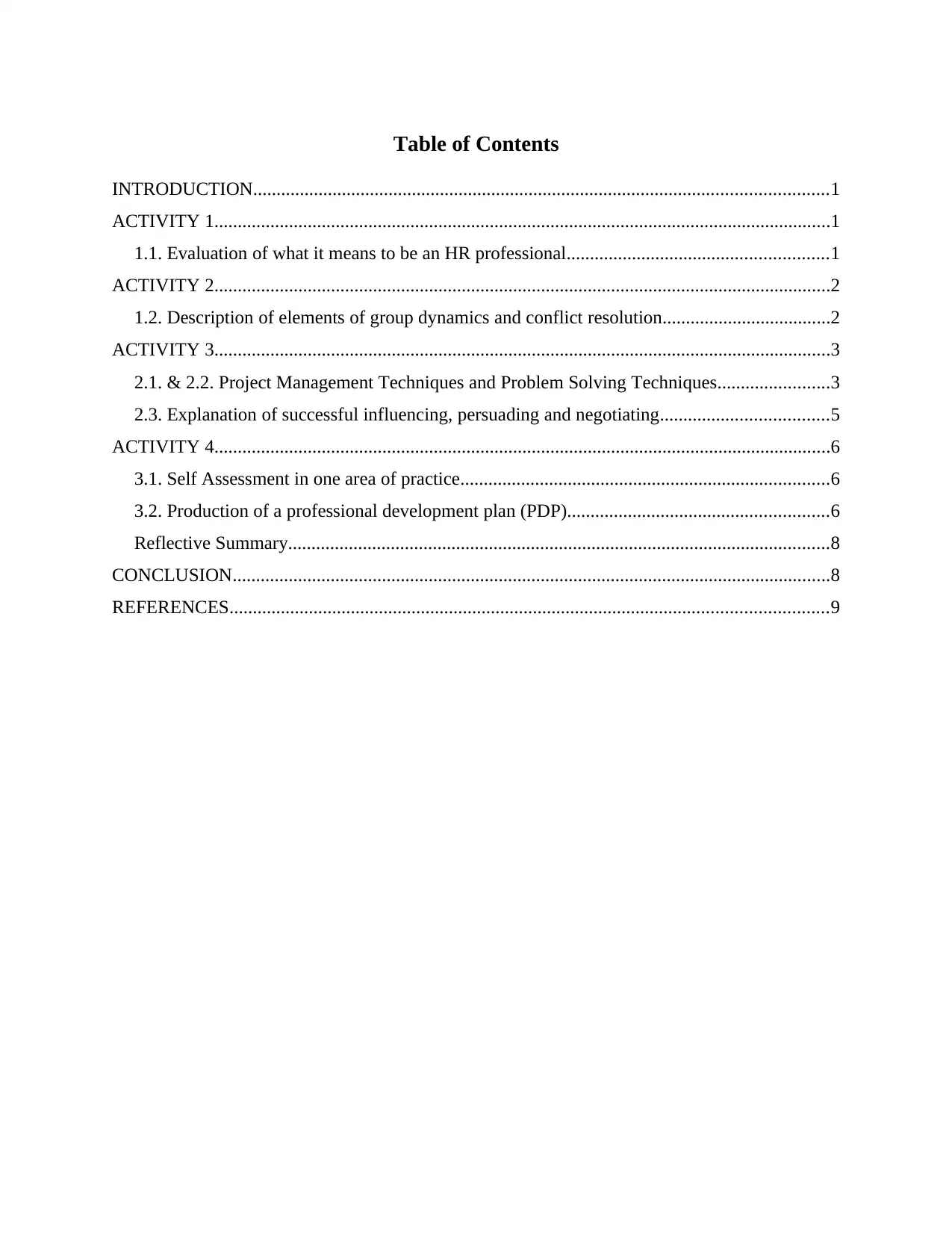
Table of Contents
INTRODUCTION...........................................................................................................................1
ACTIVITY 1....................................................................................................................................1
1.1. Evaluation of what it means to be an HR professional........................................................1
ACTIVITY 2....................................................................................................................................2
1.2. Description of elements of group dynamics and conflict resolution....................................2
ACTIVITY 3....................................................................................................................................3
2.1. & 2.2. Project Management Techniques and Problem Solving Techniques........................3
2.3. Explanation of successful influencing, persuading and negotiating....................................5
ACTIVITY 4....................................................................................................................................6
3.1. Self Assessment in one area of practice...............................................................................6
3.2. Production of a professional development plan (PDP)........................................................6
Reflective Summary....................................................................................................................8
CONCLUSION................................................................................................................................8
REFERENCES................................................................................................................................9
INTRODUCTION...........................................................................................................................1
ACTIVITY 1....................................................................................................................................1
1.1. Evaluation of what it means to be an HR professional........................................................1
ACTIVITY 2....................................................................................................................................2
1.2. Description of elements of group dynamics and conflict resolution....................................2
ACTIVITY 3....................................................................................................................................3
2.1. & 2.2. Project Management Techniques and Problem Solving Techniques........................3
2.3. Explanation of successful influencing, persuading and negotiating....................................5
ACTIVITY 4....................................................................................................................................6
3.1. Self Assessment in one area of practice...............................................................................6
3.2. Production of a professional development plan (PDP)........................................................6
Reflective Summary....................................................................................................................8
CONCLUSION................................................................................................................................8
REFERENCES................................................................................................................................9
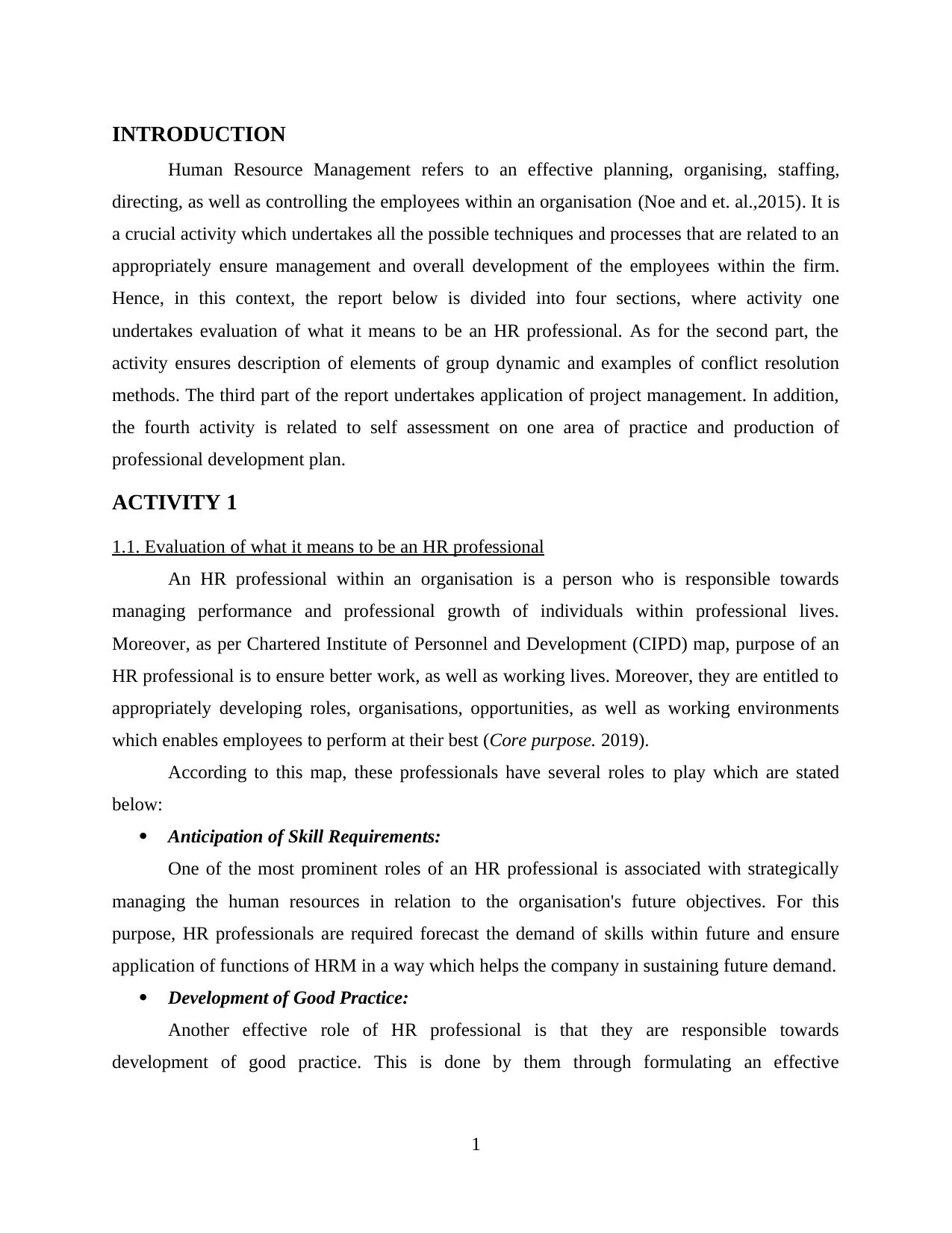
INTRODUCTION
Human Resource Management refers to an effective planning, organising, staffing,
directing, as well as controlling the employees within an organisation (Noe and et. al.,2015). It is
a crucial activity which undertakes all the possible techniques and processes that are related to an
appropriately ensure management and overall development of the employees within the firm.
Hence, in this context, the report below is divided into four sections, where activity one
undertakes evaluation of what it means to be an HR professional. As for the second part, the
activity ensures description of elements of group dynamic and examples of conflict resolution
methods. The third part of the report undertakes application of project management. In addition,
the fourth activity is related to self assessment on one area of practice and production of
professional development plan.
ACTIVITY 1
1.1. Evaluation of what it means to be an HR professional
An HR professional within an organisation is a person who is responsible towards
managing performance and professional growth of individuals within professional lives.
Moreover, as per Chartered Institute of Personnel and Development (CIPD) map, purpose of an
HR professional is to ensure better work, as well as working lives. Moreover, they are entitled to
appropriately developing roles, organisations, opportunities, as well as working environments
which enables employees to perform at their best (Core purpose. 2019).
According to this map, these professionals have several roles to play which are stated
below:
Anticipation of Skill Requirements:
One of the most prominent roles of an HR professional is associated with strategically
managing the human resources in relation to the organisation's future objectives. For this
purpose, HR professionals are required forecast the demand of skills within future and ensure
application of functions of HRM in a way which helps the company in sustaining future demand.
Development of Good Practice:
Another effective role of HR professional is that they are responsible towards
development of good practice. This is done by them through formulating an effective
1
Human Resource Management refers to an effective planning, organising, staffing,
directing, as well as controlling the employees within an organisation (Noe and et. al.,2015). It is
a crucial activity which undertakes all the possible techniques and processes that are related to an
appropriately ensure management and overall development of the employees within the firm.
Hence, in this context, the report below is divided into four sections, where activity one
undertakes evaluation of what it means to be an HR professional. As for the second part, the
activity ensures description of elements of group dynamic and examples of conflict resolution
methods. The third part of the report undertakes application of project management. In addition,
the fourth activity is related to self assessment on one area of practice and production of
professional development plan.
ACTIVITY 1
1.1. Evaluation of what it means to be an HR professional
An HR professional within an organisation is a person who is responsible towards
managing performance and professional growth of individuals within professional lives.
Moreover, as per Chartered Institute of Personnel and Development (CIPD) map, purpose of an
HR professional is to ensure better work, as well as working lives. Moreover, they are entitled to
appropriately developing roles, organisations, opportunities, as well as working environments
which enables employees to perform at their best (Core purpose. 2019).
According to this map, these professionals have several roles to play which are stated
below:
Anticipation of Skill Requirements:
One of the most prominent roles of an HR professional is associated with strategically
managing the human resources in relation to the organisation's future objectives. For this
purpose, HR professionals are required forecast the demand of skills within future and ensure
application of functions of HRM in a way which helps the company in sustaining future demand.
Development of Good Practice:
Another effective role of HR professional is that they are responsible towards
development of good practice. This is done by them through formulating an effective
1
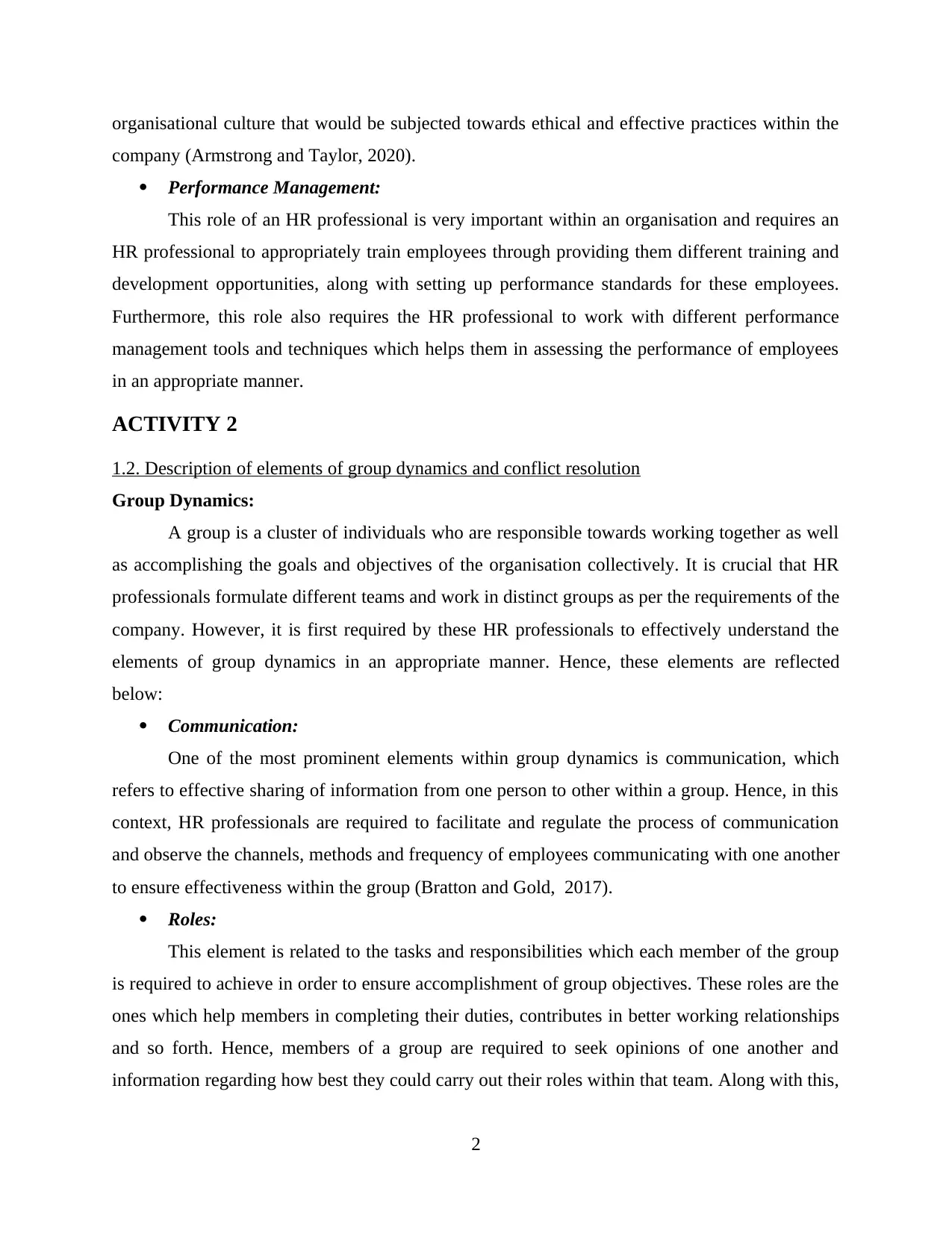
organisational culture that would be subjected towards ethical and effective practices within the
company (Armstrong and Taylor, 2020).
Performance Management:
This role of an HR professional is very important within an organisation and requires an
HR professional to appropriately train employees through providing them different training and
development opportunities, along with setting up performance standards for these employees.
Furthermore, this role also requires the HR professional to work with different performance
management tools and techniques which helps them in assessing the performance of employees
in an appropriate manner.
ACTIVITY 2
1.2. Description of elements of group dynamics and conflict resolution
Group Dynamics:
A group is a cluster of individuals who are responsible towards working together as well
as accomplishing the goals and objectives of the organisation collectively. It is crucial that HR
professionals formulate different teams and work in distinct groups as per the requirements of the
company. However, it is first required by these HR professionals to effectively understand the
elements of group dynamics in an appropriate manner. Hence, these elements are reflected
below:
Communication:
One of the most prominent elements within group dynamics is communication, which
refers to effective sharing of information from one person to other within a group. Hence, in this
context, HR professionals are required to facilitate and regulate the process of communication
and observe the channels, methods and frequency of employees communicating with one another
to ensure effectiveness within the group (Bratton and Gold, 2017).
Roles:
This element is related to the tasks and responsibilities which each member of the group
is required to achieve in order to ensure accomplishment of group objectives. These roles are the
ones which help members in completing their duties, contributes in better working relationships
and so forth. Hence, members of a group are required to seek opinions of one another and
information regarding how best they could carry out their roles within that team. Along with this,
2
company (Armstrong and Taylor, 2020).
Performance Management:
This role of an HR professional is very important within an organisation and requires an
HR professional to appropriately train employees through providing them different training and
development opportunities, along with setting up performance standards for these employees.
Furthermore, this role also requires the HR professional to work with different performance
management tools and techniques which helps them in assessing the performance of employees
in an appropriate manner.
ACTIVITY 2
1.2. Description of elements of group dynamics and conflict resolution
Group Dynamics:
A group is a cluster of individuals who are responsible towards working together as well
as accomplishing the goals and objectives of the organisation collectively. It is crucial that HR
professionals formulate different teams and work in distinct groups as per the requirements of the
company. However, it is first required by these HR professionals to effectively understand the
elements of group dynamics in an appropriate manner. Hence, these elements are reflected
below:
Communication:
One of the most prominent elements within group dynamics is communication, which
refers to effective sharing of information from one person to other within a group. Hence, in this
context, HR professionals are required to facilitate and regulate the process of communication
and observe the channels, methods and frequency of employees communicating with one another
to ensure effectiveness within the group (Bratton and Gold, 2017).
Roles:
This element is related to the tasks and responsibilities which each member of the group
is required to achieve in order to ensure accomplishment of group objectives. These roles are the
ones which help members in completing their duties, contributes in better working relationships
and so forth. Hence, members of a group are required to seek opinions of one another and
information regarding how best they could carry out their roles within that team. Along with this,
2
Secure Best Marks with AI Grader
Need help grading? Try our AI Grader for instant feedback on your assignments.
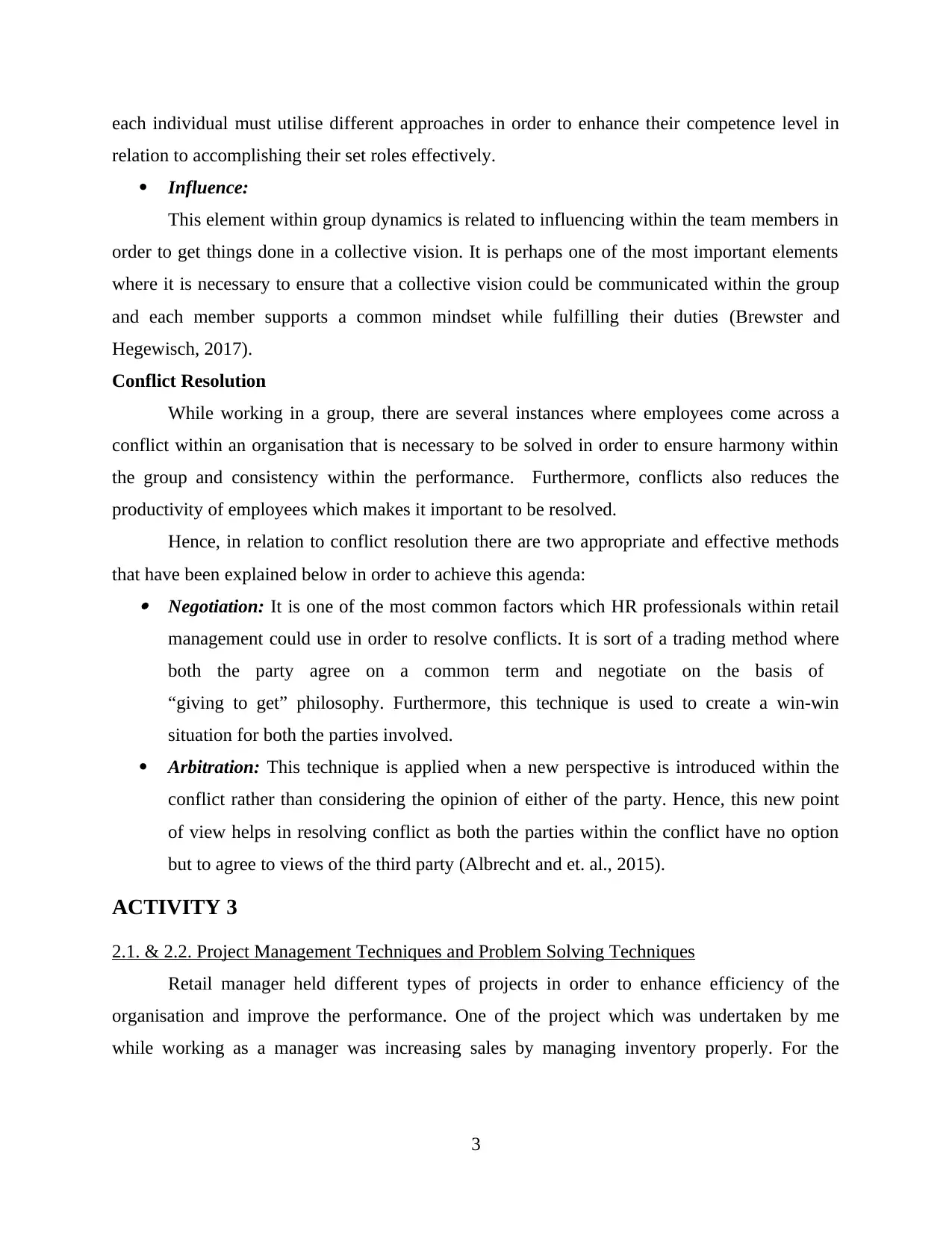
each individual must utilise different approaches in order to enhance their competence level in
relation to accomplishing their set roles effectively.
Influence:
This element within group dynamics is related to influencing within the team members in
order to get things done in a collective vision. It is perhaps one of the most important elements
where it is necessary to ensure that a collective vision could be communicated within the group
and each member supports a common mindset while fulfilling their duties (Brewster and
Hegewisch, 2017).
Conflict Resolution
While working in a group, there are several instances where employees come across a
conflict within an organisation that is necessary to be solved in order to ensure harmony within
the group and consistency within the performance. Furthermore, conflicts also reduces the
productivity of employees which makes it important to be resolved.
Hence, in relation to conflict resolution there are two appropriate and effective methods
that have been explained below in order to achieve this agenda: Negotiation: It is one of the most common factors which HR professionals within retail
management could use in order to resolve conflicts. It is sort of a trading method where
both the party agree on a common term and negotiate on the basis of
“giving to get” philosophy. Furthermore, this technique is used to create a win-win
situation for both the parties involved.
Arbitration: This technique is applied when a new perspective is introduced within the
conflict rather than considering the opinion of either of the party. Hence, this new point
of view helps in resolving conflict as both the parties within the conflict have no option
but to agree to views of the third party (Albrecht and et. al., 2015).
ACTIVITY 3
2.1. & 2.2. Project Management Techniques and Problem Solving Techniques
Retail manager held different types of projects in order to enhance efficiency of the
organisation and improve the performance. One of the project which was undertaken by me
while working as a manager was increasing sales by managing inventory properly. For the
3
relation to accomplishing their set roles effectively.
Influence:
This element within group dynamics is related to influencing within the team members in
order to get things done in a collective vision. It is perhaps one of the most important elements
where it is necessary to ensure that a collective vision could be communicated within the group
and each member supports a common mindset while fulfilling their duties (Brewster and
Hegewisch, 2017).
Conflict Resolution
While working in a group, there are several instances where employees come across a
conflict within an organisation that is necessary to be solved in order to ensure harmony within
the group and consistency within the performance. Furthermore, conflicts also reduces the
productivity of employees which makes it important to be resolved.
Hence, in relation to conflict resolution there are two appropriate and effective methods
that have been explained below in order to achieve this agenda: Negotiation: It is one of the most common factors which HR professionals within retail
management could use in order to resolve conflicts. It is sort of a trading method where
both the party agree on a common term and negotiate on the basis of
“giving to get” philosophy. Furthermore, this technique is used to create a win-win
situation for both the parties involved.
Arbitration: This technique is applied when a new perspective is introduced within the
conflict rather than considering the opinion of either of the party. Hence, this new point
of view helps in resolving conflict as both the parties within the conflict have no option
but to agree to views of the third party (Albrecht and et. al., 2015).
ACTIVITY 3
2.1. & 2.2. Project Management Techniques and Problem Solving Techniques
Retail manager held different types of projects in order to enhance efficiency of the
organisation and improve the performance. One of the project which was undertaken by me
while working as a manager was increasing sales by managing inventory properly. For the
3
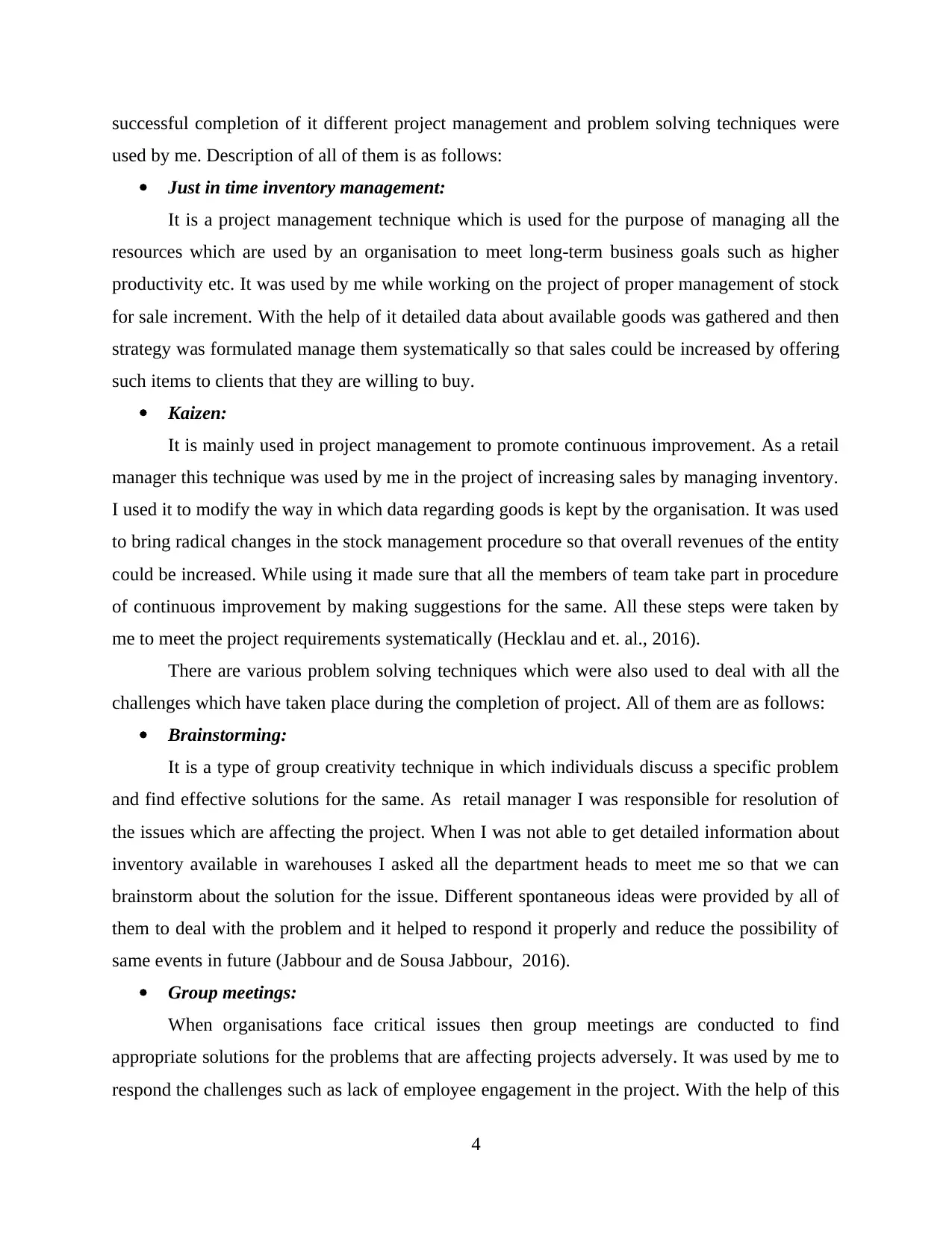
successful completion of it different project management and problem solving techniques were
used by me. Description of all of them is as follows:
Just in time inventory management:
It is a project management technique which is used for the purpose of managing all the
resources which are used by an organisation to meet long-term business goals such as higher
productivity etc. It was used by me while working on the project of proper management of stock
for sale increment. With the help of it detailed data about available goods was gathered and then
strategy was formulated manage them systematically so that sales could be increased by offering
such items to clients that they are willing to buy.
Kaizen:
It is mainly used in project management to promote continuous improvement. As a retail
manager this technique was used by me in the project of increasing sales by managing inventory.
I used it to modify the way in which data regarding goods is kept by the organisation. It was used
to bring radical changes in the stock management procedure so that overall revenues of the entity
could be increased. While using it made sure that all the members of team take part in procedure
of continuous improvement by making suggestions for the same. All these steps were taken by
me to meet the project requirements systematically (Hecklau and et. al., 2016).
There are various problem solving techniques which were also used to deal with all the
challenges which have taken place during the completion of project. All of them are as follows:
Brainstorming:
It is a type of group creativity technique in which individuals discuss a specific problem
and find effective solutions for the same. As retail manager I was responsible for resolution of
the issues which are affecting the project. When I was not able to get detailed information about
inventory available in warehouses I asked all the department heads to meet me so that we can
brainstorm about the solution for the issue. Different spontaneous ideas were provided by all of
them to deal with the problem and it helped to respond it properly and reduce the possibility of
same events in future (Jabbour and de Sousa Jabbour, 2016).
Group meetings:
When organisations face critical issues then group meetings are conducted to find
appropriate solutions for the problems that are affecting projects adversely. It was used by me to
respond the challenges such as lack of employee engagement in the project. With the help of this
4
used by me. Description of all of them is as follows:
Just in time inventory management:
It is a project management technique which is used for the purpose of managing all the
resources which are used by an organisation to meet long-term business goals such as higher
productivity etc. It was used by me while working on the project of proper management of stock
for sale increment. With the help of it detailed data about available goods was gathered and then
strategy was formulated manage them systematically so that sales could be increased by offering
such items to clients that they are willing to buy.
Kaizen:
It is mainly used in project management to promote continuous improvement. As a retail
manager this technique was used by me in the project of increasing sales by managing inventory.
I used it to modify the way in which data regarding goods is kept by the organisation. It was used
to bring radical changes in the stock management procedure so that overall revenues of the entity
could be increased. While using it made sure that all the members of team take part in procedure
of continuous improvement by making suggestions for the same. All these steps were taken by
me to meet the project requirements systematically (Hecklau and et. al., 2016).
There are various problem solving techniques which were also used to deal with all the
challenges which have taken place during the completion of project. All of them are as follows:
Brainstorming:
It is a type of group creativity technique in which individuals discuss a specific problem
and find effective solutions for the same. As retail manager I was responsible for resolution of
the issues which are affecting the project. When I was not able to get detailed information about
inventory available in warehouses I asked all the department heads to meet me so that we can
brainstorm about the solution for the issue. Different spontaneous ideas were provided by all of
them to deal with the problem and it helped to respond it properly and reduce the possibility of
same events in future (Jabbour and de Sousa Jabbour, 2016).
Group meetings:
When organisations face critical issues then group meetings are conducted to find
appropriate solutions for the problems that are affecting projects adversely. It was used by me to
respond the challenges such as lack of employee engagement in the project. With the help of this
4
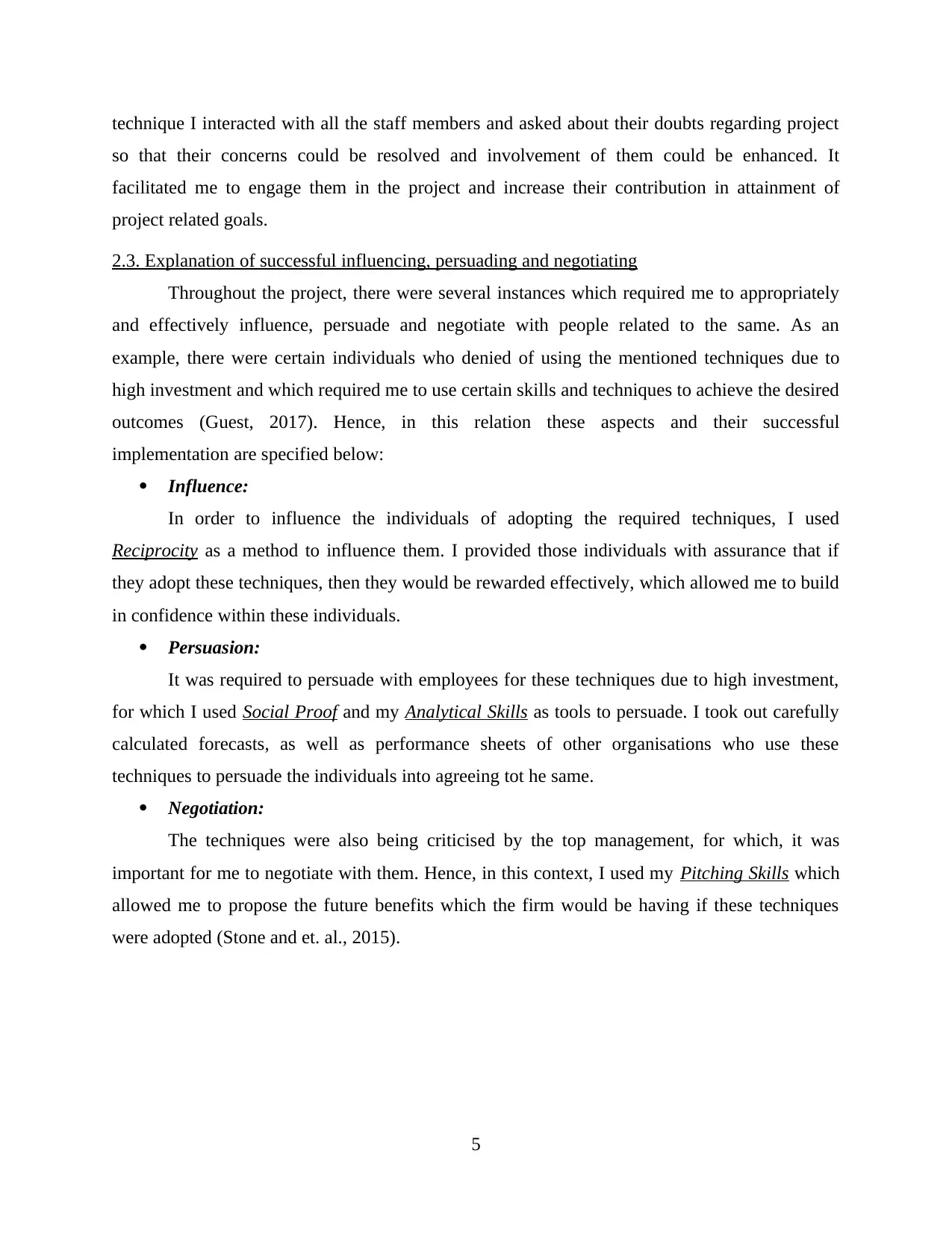
technique I interacted with all the staff members and asked about their doubts regarding project
so that their concerns could be resolved and involvement of them could be enhanced. It
facilitated me to engage them in the project and increase their contribution in attainment of
project related goals.
2.3. Explanation of successful influencing, persuading and negotiating
Throughout the project, there were several instances which required me to appropriately
and effectively influence, persuade and negotiate with people related to the same. As an
example, there were certain individuals who denied of using the mentioned techniques due to
high investment and which required me to use certain skills and techniques to achieve the desired
outcomes (Guest, 2017). Hence, in this relation these aspects and their successful
implementation are specified below:
Influence:
In order to influence the individuals of adopting the required techniques, I used
Reciprocity as a method to influence them. I provided those individuals with assurance that if
they adopt these techniques, then they would be rewarded effectively, which allowed me to build
in confidence within these individuals.
Persuasion:
It was required to persuade with employees for these techniques due to high investment,
for which I used Social Proof and my Analytical Skills as tools to persuade. I took out carefully
calculated forecasts, as well as performance sheets of other organisations who use these
techniques to persuade the individuals into agreeing tot he same.
Negotiation:
The techniques were also being criticised by the top management, for which, it was
important for me to negotiate with them. Hence, in this context, I used my Pitching Skills which
allowed me to propose the future benefits which the firm would be having if these techniques
were adopted (Stone and et. al., 2015).
5
so that their concerns could be resolved and involvement of them could be enhanced. It
facilitated me to engage them in the project and increase their contribution in attainment of
project related goals.
2.3. Explanation of successful influencing, persuading and negotiating
Throughout the project, there were several instances which required me to appropriately
and effectively influence, persuade and negotiate with people related to the same. As an
example, there were certain individuals who denied of using the mentioned techniques due to
high investment and which required me to use certain skills and techniques to achieve the desired
outcomes (Guest, 2017). Hence, in this relation these aspects and their successful
implementation are specified below:
Influence:
In order to influence the individuals of adopting the required techniques, I used
Reciprocity as a method to influence them. I provided those individuals with assurance that if
they adopt these techniques, then they would be rewarded effectively, which allowed me to build
in confidence within these individuals.
Persuasion:
It was required to persuade with employees for these techniques due to high investment,
for which I used Social Proof and my Analytical Skills as tools to persuade. I took out carefully
calculated forecasts, as well as performance sheets of other organisations who use these
techniques to persuade the individuals into agreeing tot he same.
Negotiation:
The techniques were also being criticised by the top management, for which, it was
important for me to negotiate with them. Hence, in this context, I used my Pitching Skills which
allowed me to propose the future benefits which the firm would be having if these techniques
were adopted (Stone and et. al., 2015).
5
Paraphrase This Document
Need a fresh take? Get an instant paraphrase of this document with our AI Paraphraser
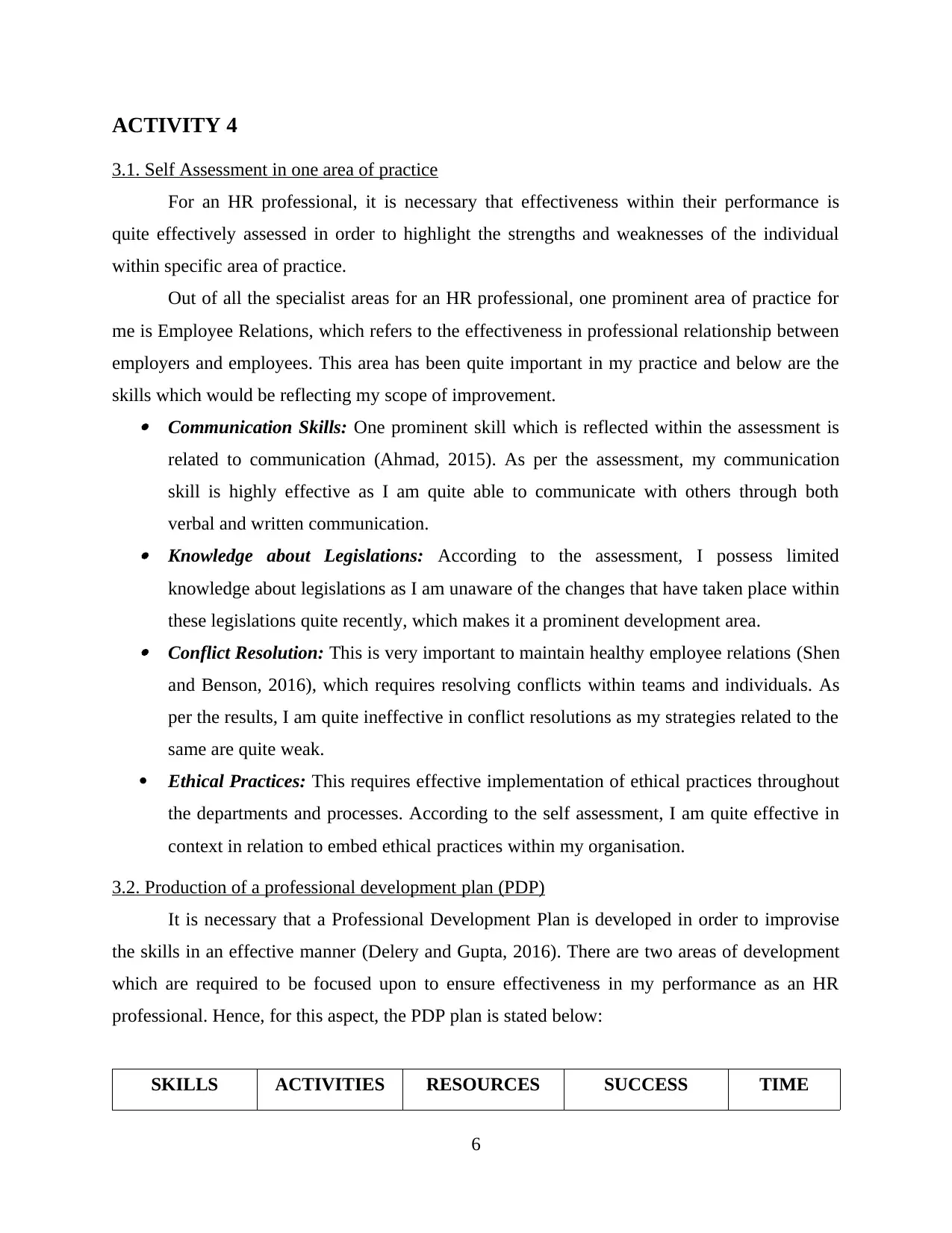
ACTIVITY 4
3.1. Self Assessment in one area of practice
For an HR professional, it is necessary that effectiveness within their performance is
quite effectively assessed in order to highlight the strengths and weaknesses of the individual
within specific area of practice.
Out of all the specialist areas for an HR professional, one prominent area of practice for
me is Employee Relations, which refers to the effectiveness in professional relationship between
employers and employees. This area has been quite important in my practice and below are the
skills which would be reflecting my scope of improvement. Communication Skills: One prominent skill which is reflected within the assessment is
related to communication (Ahmad, 2015). As per the assessment, my communication
skill is highly effective as I am quite able to communicate with others through both
verbal and written communication. Knowledge about Legislations: According to the assessment, I possess limited
knowledge about legislations as I am unaware of the changes that have taken place within
these legislations quite recently, which makes it a prominent development area. Conflict Resolution: This is very important to maintain healthy employee relations (Shen
and Benson, 2016), which requires resolving conflicts within teams and individuals. As
per the results, I am quite ineffective in conflict resolutions as my strategies related to the
same are quite weak.
Ethical Practices: This requires effective implementation of ethical practices throughout
the departments and processes. According to the self assessment, I am quite effective in
context in relation to embed ethical practices within my organisation.
3.2. Production of a professional development plan (PDP)
It is necessary that a Professional Development Plan is developed in order to improvise
the skills in an effective manner (Delery and Gupta, 2016). There are two areas of development
which are required to be focused upon to ensure effectiveness in my performance as an HR
professional. Hence, for this aspect, the PDP plan is stated below:
SKILLS ACTIVITIES RESOURCES SUCCESS TIME
6
3.1. Self Assessment in one area of practice
For an HR professional, it is necessary that effectiveness within their performance is
quite effectively assessed in order to highlight the strengths and weaknesses of the individual
within specific area of practice.
Out of all the specialist areas for an HR professional, one prominent area of practice for
me is Employee Relations, which refers to the effectiveness in professional relationship between
employers and employees. This area has been quite important in my practice and below are the
skills which would be reflecting my scope of improvement. Communication Skills: One prominent skill which is reflected within the assessment is
related to communication (Ahmad, 2015). As per the assessment, my communication
skill is highly effective as I am quite able to communicate with others through both
verbal and written communication. Knowledge about Legislations: According to the assessment, I possess limited
knowledge about legislations as I am unaware of the changes that have taken place within
these legislations quite recently, which makes it a prominent development area. Conflict Resolution: This is very important to maintain healthy employee relations (Shen
and Benson, 2016), which requires resolving conflicts within teams and individuals. As
per the results, I am quite ineffective in conflict resolutions as my strategies related to the
same are quite weak.
Ethical Practices: This requires effective implementation of ethical practices throughout
the departments and processes. According to the self assessment, I am quite effective in
context in relation to embed ethical practices within my organisation.
3.2. Production of a professional development plan (PDP)
It is necessary that a Professional Development Plan is developed in order to improvise
the skills in an effective manner (Delery and Gupta, 2016). There are two areas of development
which are required to be focused upon to ensure effectiveness in my performance as an HR
professional. Hence, for this aspect, the PDP plan is stated below:
SKILLS ACTIVITIES RESOURCES SUCCESS TIME
6
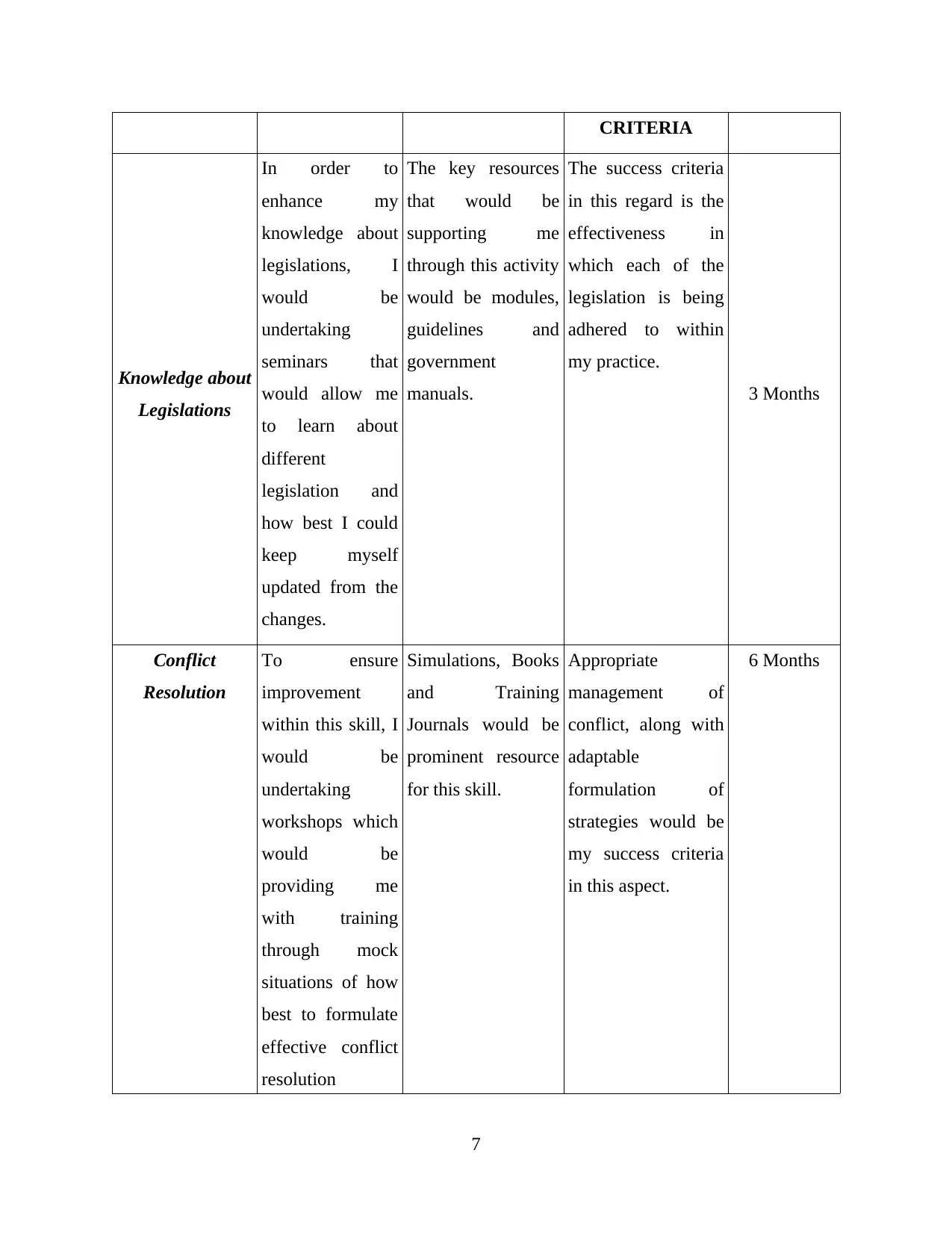
CRITERIA
Knowledge about
Legislations
In order to
enhance my
knowledge about
legislations, I
would be
undertaking
seminars that
would allow me
to learn about
different
legislation and
how best I could
keep myself
updated from the
changes.
The key resources
that would be
supporting me
through this activity
would be modules,
guidelines and
government
manuals.
The success criteria
in this regard is the
effectiveness in
which each of the
legislation is being
adhered to within
my practice.
3 Months
Conflict
Resolution
To ensure
improvement
within this skill, I
would be
undertaking
workshops which
would be
providing me
with training
through mock
situations of how
best to formulate
effective conflict
resolution
Simulations, Books
and Training
Journals would be
prominent resource
for this skill.
Appropriate
management of
conflict, along with
adaptable
formulation of
strategies would be
my success criteria
in this aspect.
6 Months
7
Knowledge about
Legislations
In order to
enhance my
knowledge about
legislations, I
would be
undertaking
seminars that
would allow me
to learn about
different
legislation and
how best I could
keep myself
updated from the
changes.
The key resources
that would be
supporting me
through this activity
would be modules,
guidelines and
government
manuals.
The success criteria
in this regard is the
effectiveness in
which each of the
legislation is being
adhered to within
my practice.
3 Months
Conflict
Resolution
To ensure
improvement
within this skill, I
would be
undertaking
workshops which
would be
providing me
with training
through mock
situations of how
best to formulate
effective conflict
resolution
Simulations, Books
and Training
Journals would be
prominent resource
for this skill.
Appropriate
management of
conflict, along with
adaptable
formulation of
strategies would be
my success criteria
in this aspect.
6 Months
7
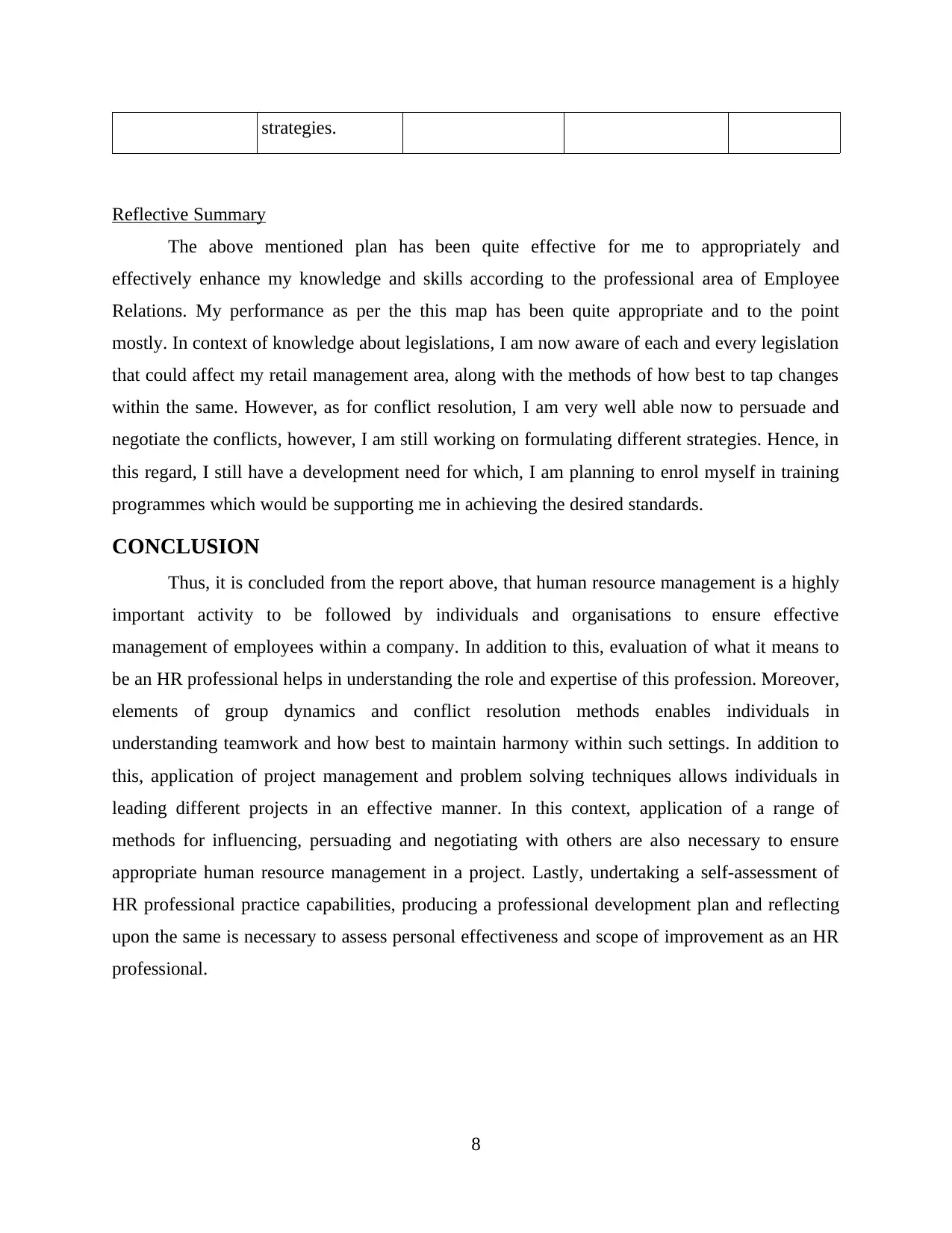
strategies.
Reflective Summary
The above mentioned plan has been quite effective for me to appropriately and
effectively enhance my knowledge and skills according to the professional area of Employee
Relations. My performance as per the this map has been quite appropriate and to the point
mostly. In context of knowledge about legislations, I am now aware of each and every legislation
that could affect my retail management area, along with the methods of how best to tap changes
within the same. However, as for conflict resolution, I am very well able now to persuade and
negotiate the conflicts, however, I am still working on formulating different strategies. Hence, in
this regard, I still have a development need for which, I am planning to enrol myself in training
programmes which would be supporting me in achieving the desired standards.
CONCLUSION
Thus, it is concluded from the report above, that human resource management is a highly
important activity to be followed by individuals and organisations to ensure effective
management of employees within a company. In addition to this, evaluation of what it means to
be an HR professional helps in understanding the role and expertise of this profession. Moreover,
elements of group dynamics and conflict resolution methods enables individuals in
understanding teamwork and how best to maintain harmony within such settings. In addition to
this, application of project management and problem solving techniques allows individuals in
leading different projects in an effective manner. In this context, application of a range of
methods for influencing, persuading and negotiating with others are also necessary to ensure
appropriate human resource management in a project. Lastly, undertaking a self-assessment of
HR professional practice capabilities, producing a professional development plan and reflecting
upon the same is necessary to assess personal effectiveness and scope of improvement as an HR
professional.
8
Reflective Summary
The above mentioned plan has been quite effective for me to appropriately and
effectively enhance my knowledge and skills according to the professional area of Employee
Relations. My performance as per the this map has been quite appropriate and to the point
mostly. In context of knowledge about legislations, I am now aware of each and every legislation
that could affect my retail management area, along with the methods of how best to tap changes
within the same. However, as for conflict resolution, I am very well able now to persuade and
negotiate the conflicts, however, I am still working on formulating different strategies. Hence, in
this regard, I still have a development need for which, I am planning to enrol myself in training
programmes which would be supporting me in achieving the desired standards.
CONCLUSION
Thus, it is concluded from the report above, that human resource management is a highly
important activity to be followed by individuals and organisations to ensure effective
management of employees within a company. In addition to this, evaluation of what it means to
be an HR professional helps in understanding the role and expertise of this profession. Moreover,
elements of group dynamics and conflict resolution methods enables individuals in
understanding teamwork and how best to maintain harmony within such settings. In addition to
this, application of project management and problem solving techniques allows individuals in
leading different projects in an effective manner. In this context, application of a range of
methods for influencing, persuading and negotiating with others are also necessary to ensure
appropriate human resource management in a project. Lastly, undertaking a self-assessment of
HR professional practice capabilities, producing a professional development plan and reflecting
upon the same is necessary to assess personal effectiveness and scope of improvement as an HR
professional.
8
Secure Best Marks with AI Grader
Need help grading? Try our AI Grader for instant feedback on your assignments.
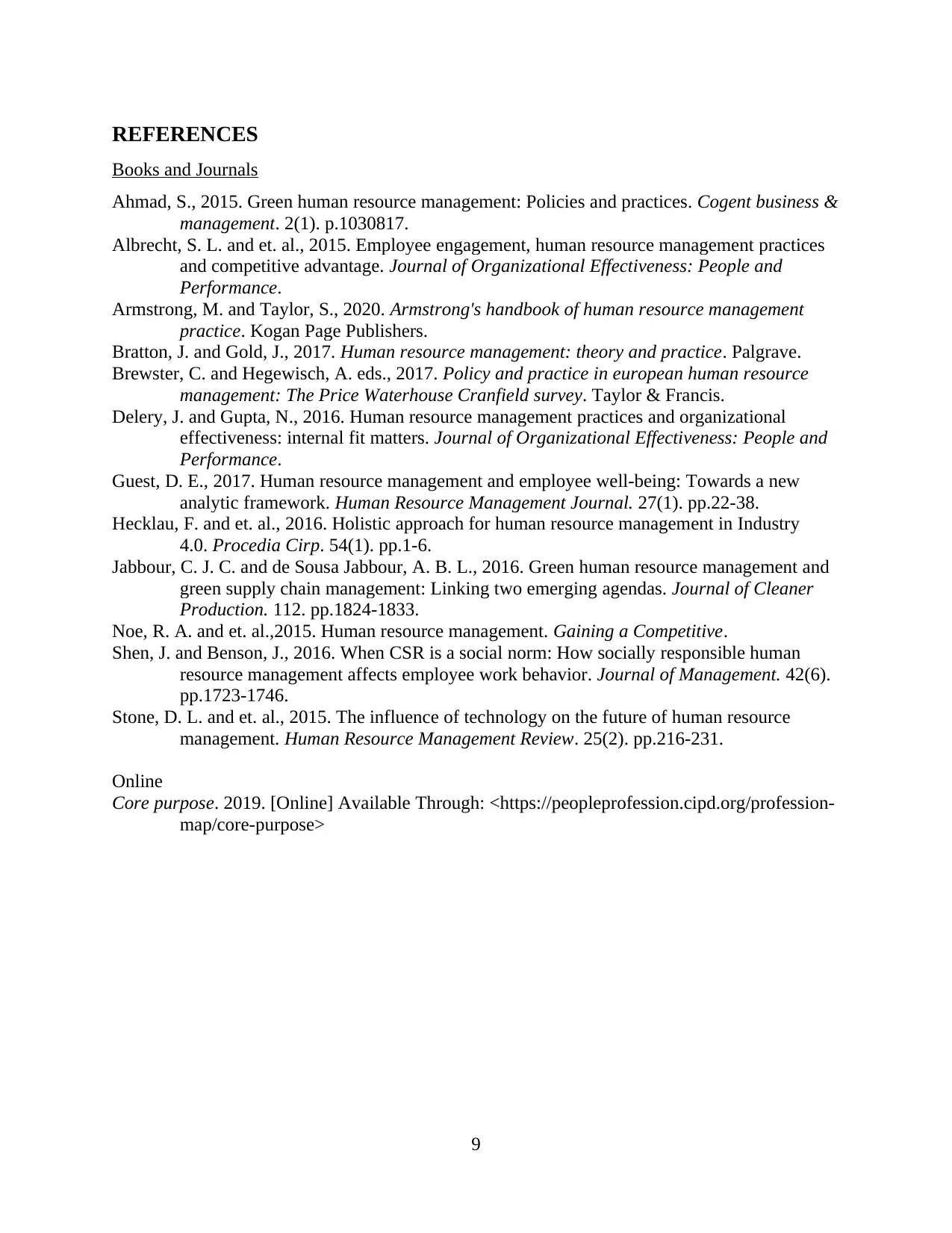
REFERENCES
Books and Journals
Ahmad, S., 2015. Green human resource management: Policies and practices. Cogent business &
management. 2(1). p.1030817.
Albrecht, S. L. and et. al., 2015. Employee engagement, human resource management practices
and competitive advantage. Journal of Organizational Effectiveness: People and
Performance.
Armstrong, M. and Taylor, S., 2020. Armstrong's handbook of human resource management
practice. Kogan Page Publishers.
Bratton, J. and Gold, J., 2017. Human resource management: theory and practice. Palgrave.
Brewster, C. and Hegewisch, A. eds., 2017. Policy and practice in european human resource
management: The Price Waterhouse Cranfield survey. Taylor & Francis.
Delery, J. and Gupta, N., 2016. Human resource management practices and organizational
effectiveness: internal fit matters. Journal of Organizational Effectiveness: People and
Performance.
Guest, D. E., 2017. Human resource management and employee well‐being: Towards a new
analytic framework. Human Resource Management Journal. 27(1). pp.22-38.
Hecklau, F. and et. al., 2016. Holistic approach for human resource management in Industry
4.0. Procedia Cirp. 54(1). pp.1-6.
Jabbour, C. J. C. and de Sousa Jabbour, A. B. L., 2016. Green human resource management and
green supply chain management: Linking two emerging agendas. Journal of Cleaner
Production. 112. pp.1824-1833.
Noe, R. A. and et. al.,2015. Human resource management. Gaining a Competitive.
Shen, J. and Benson, J., 2016. When CSR is a social norm: How socially responsible human
resource management affects employee work behavior. Journal of Management. 42(6).
pp.1723-1746.
Stone, D. L. and et. al., 2015. The influence of technology on the future of human resource
management. Human Resource Management Review. 25(2). pp.216-231.
Online
Core purpose. 2019. [Online] Available Through: <https://peopleprofession.cipd.org/profession-
map/core-purpose>
9
Books and Journals
Ahmad, S., 2015. Green human resource management: Policies and practices. Cogent business &
management. 2(1). p.1030817.
Albrecht, S. L. and et. al., 2015. Employee engagement, human resource management practices
and competitive advantage. Journal of Organizational Effectiveness: People and
Performance.
Armstrong, M. and Taylor, S., 2020. Armstrong's handbook of human resource management
practice. Kogan Page Publishers.
Bratton, J. and Gold, J., 2017. Human resource management: theory and practice. Palgrave.
Brewster, C. and Hegewisch, A. eds., 2017. Policy and practice in european human resource
management: The Price Waterhouse Cranfield survey. Taylor & Francis.
Delery, J. and Gupta, N., 2016. Human resource management practices and organizational
effectiveness: internal fit matters. Journal of Organizational Effectiveness: People and
Performance.
Guest, D. E., 2017. Human resource management and employee well‐being: Towards a new
analytic framework. Human Resource Management Journal. 27(1). pp.22-38.
Hecklau, F. and et. al., 2016. Holistic approach for human resource management in Industry
4.0. Procedia Cirp. 54(1). pp.1-6.
Jabbour, C. J. C. and de Sousa Jabbour, A. B. L., 2016. Green human resource management and
green supply chain management: Linking two emerging agendas. Journal of Cleaner
Production. 112. pp.1824-1833.
Noe, R. A. and et. al.,2015. Human resource management. Gaining a Competitive.
Shen, J. and Benson, J., 2016. When CSR is a social norm: How socially responsible human
resource management affects employee work behavior. Journal of Management. 42(6).
pp.1723-1746.
Stone, D. L. and et. al., 2015. The influence of technology on the future of human resource
management. Human Resource Management Review. 25(2). pp.216-231.
Online
Core purpose. 2019. [Online] Available Through: <https://peopleprofession.cipd.org/profession-
map/core-purpose>
9
1 out of 11
Related Documents
Your All-in-One AI-Powered Toolkit for Academic Success.
+13062052269
info@desklib.com
Available 24*7 on WhatsApp / Email
![[object Object]](/_next/static/media/star-bottom.7253800d.svg)
Unlock your academic potential
© 2024 | Zucol Services PVT LTD | All rights reserved.





